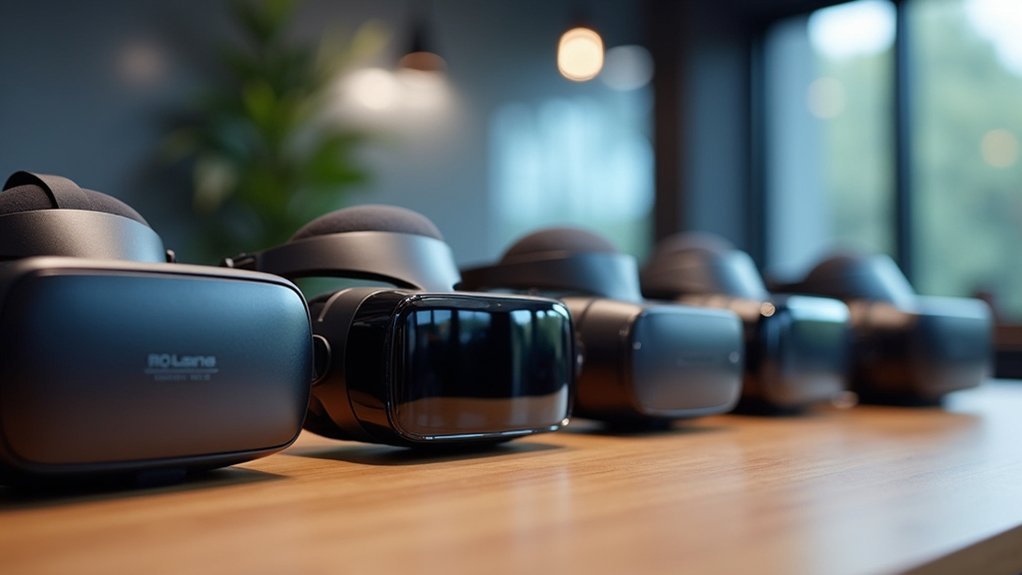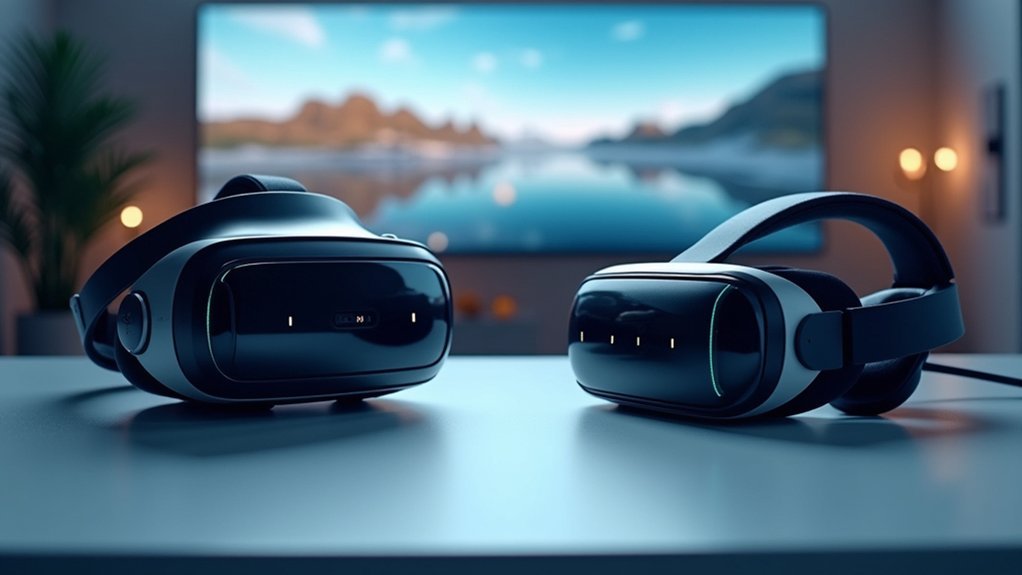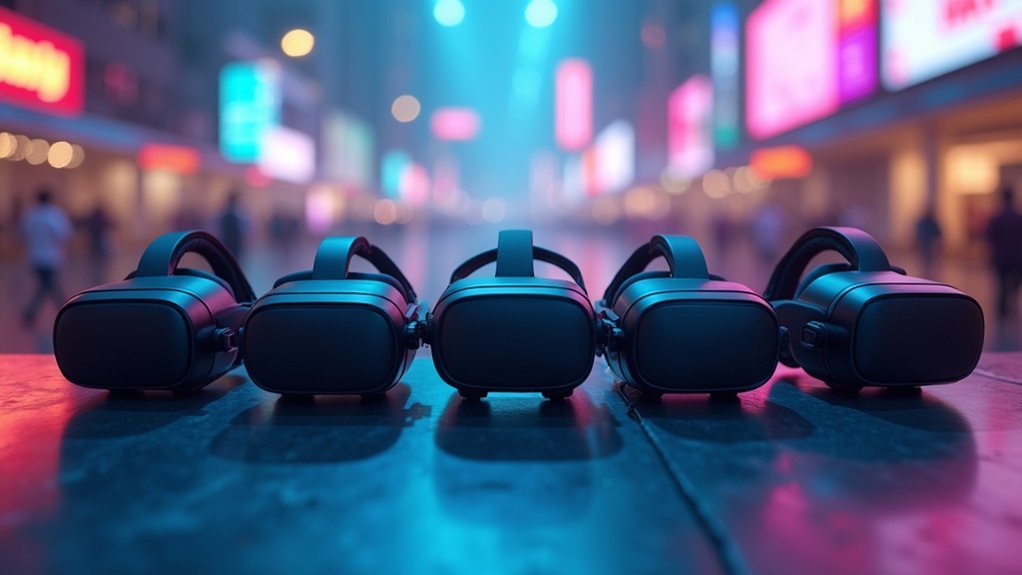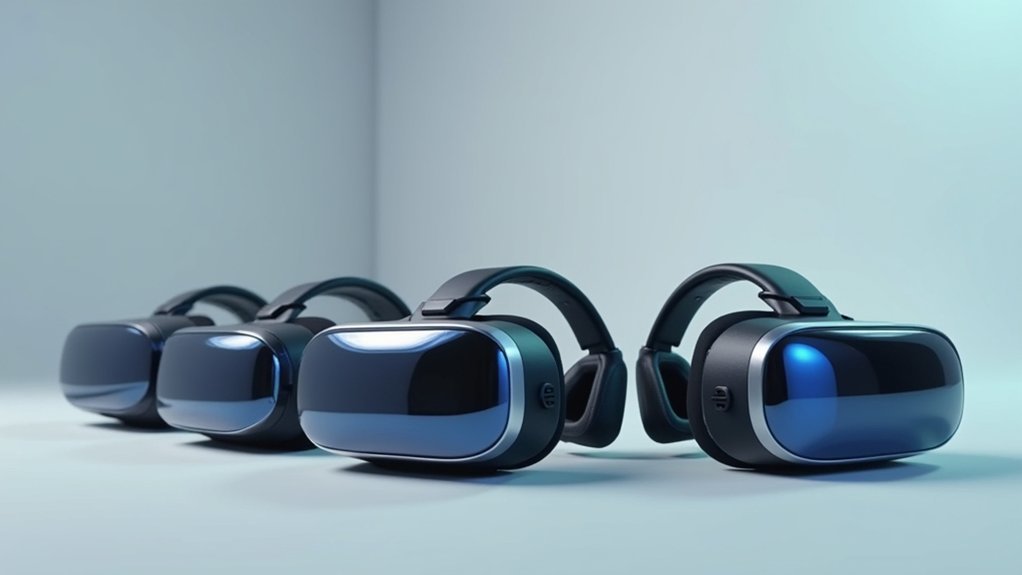The market’s widest field-of-view VR headsets include the Pimax Crystal at 130° diagonal FOV, Somnium VR1 with 130° horizontal FOV, and Valve Index offering impressive peripheral vision. HTC VIVE XR Elite provides 110° FOV for mid-range users, while Varjo XR-4 delivers premium visuals with considerable viewing angles. You’ll experience greatly reduced “looking through binoculars” sensation with these headsets, creating stronger presence and immersion. The following comparison reveals how these expanded perspectives transform both gaming and professional applications.
Understanding Field-of-View in Modern VR Headsets

Three key aspects define a VR headset’s immersive quality, and field-of-view (FOV) stands at the forefront of these elements.
When you don a VR headset, FOV represents how much of the virtual world you can see without moving your head—typically measured in degrees.
While human vision spans approximately 180 degrees horizontally, most VR headsets still can’t match this natural capability. Modern headsets like the Varjo XR-4 Series offer 120° horizontal FOV, bringing users closer to natural vision capabilities. Your experience in virtual worlds depends considerably on this specification; wider FOVs create stronger presence and reduce that limiting “looking through binoculars” sensation.
There’s always a tradeoff, though. Expanding FOV requires more complex lens designs and demands greater processing power from your hardware.
This balance between immersion and technical limitations continues to drive innovation in the VR industry.
Pimax Crystal: Leading the Market With 130° FOV
The Pimax Crystal stands at the forefront of immersive VR technology with its impressive 130° diagonal field-of-view, setting a new standard for consumer headsets.
The Crystal redefines VR immersion with its revolutionary 130° FOV, establishing a new benchmark for consumer headsets.
You’ll experience 115° horizontal and 105° vertical FOV, dramatically expanding your peripheral vision compared to competitors.
Beyond its wide FOV, the Crystal delivers stunning visuals with 2880×2880 pixels per eye and 35 PPD density.
The QLED panels combined with Mini-LED technology guarantee vibrant colors and deep blacks, especially with local dimming enabled.
For users seeking even greater immersion, the optional Big FOV lens increases the field-of-view while still maintaining the impressive 35PPD clarity in the center.
The headset offers flexible 60-120Hz refresh rates and supports both inside-out tracking and optional Lighthouse compatibility.
Despite its premium features, the 815g weight remains comfortable for extended sessions, making it particularly popular among sim enthusiasts and VR arcades requiring exceptional immersion.
Comparing Premium Options: Somnium VR1 vs. Varjo XR-4

While the Pimax Crystal offers exceptional immersion for enthusiasts, two other premium headsets deserve attention in our wide FOV comparison. The Somnium VR1 stands out with its impressive 130° horizontal FOV, matching the Pimax Crystal while offering multiple refresh rate options up to 144Hz. The lightweight design makes it comfortable for extended gaming sessions without strain. The Varjo XR-4, though lacking specific FOV measurements in our data, counters with superior OLED display technology for enhanced contrast.
| Feature | Somnium VR1 | Varjo XR-4 |
|---|---|---|
| Display | QLED Mini-LED | OLED |
| Resolution | 2880 x 2880 per eye | High (specific details N/A) |
| FOV | 130° horizontal, 105° vertical | Wide (specific details N/A) |
| Refresh Rate | 75, 90, 120, 144 Hz | High (specific details N/A) |
| Eye Tracking | 120Hz open-source | Advanced capabilities |
Mid-Range Excellence: HTC VIVE XR Elite and Alternatives
Diving into the mid-range market, HTC’s VIVE XR Elite emerges as a standout option for users seeking wide field-of-view experiences without premium price tags.
With a respectable 110-degree FOV and crisp 1920 x 1920 per-eye resolution at 90Hz, this portable headset delivers immersive visuals while maintaining independence from external hardware. The headset features convenient eye comfort adjustment for an interpupillary distance range of 54 to 73 mm, ensuring optimal viewing for various users.
You’ll find several compelling alternatives worth considering.
Meta Quest Pro offers advanced tracking with a 95-degree FOV, while Valve Index provides high-end experiences with superior tracking.
The Oculus Quest 2 matches the XR Elite’s FOV in some applications, and HP’s Reverb G2 targets enterprise users with exceptional clarity.
Each offers distinct advantages in the increasingly competitive mid-range VR landscape, with varying strengths in comfort, resolution, and connectivity options.
Regular software updates continue to enhance capabilities across all these options.
How Wide FOV Transforms Gaming and Professional Applications

Moving beyond hardware specifications, wide field-of-view capabilities fundamentally change how we experience virtual worlds.
Wide FOV technology isn’t just a spec upgrade—it’s redefining our relationship with virtual reality itself.
In gaming, you’ll notice enhanced immersion as wider FOVs simulate natural peripheral vision, giving you competitive advantages through improved reaction times and greater environmental awareness. The Valve Index particularly excels with its 130-degree field of view, offering superior peripheral vision compared to many competitors.
For professionals, the benefits extend beyond entertainment. Architects and designers can visualize complex projects more completely, while trainers can create more realistic simulations for healthcare and aviation applications.
You’ll experience increased productivity by seeing more information without constant head movement, and collaboration becomes more intuitive when teams share a more complete virtual environment.
While these advancements face challenges in resolution clarity and comfort, the transformative benefits of wide FOV technology continue to drive innovation in both gaming and professional applications.
Frequently Asked Questions
Do Wider FOV Headsets Cause More Motion Sickness?
Wider FOV headsets can cause initial discomfort for some people due to increased visual information, but you’ll likely adapt over time. It’s not universal, and lens quality and resolution also affect your experience.
Can Prescription Glasses Be Worn Comfortably With These Headsets?
You can wear prescription glasses comfortably with most VR headsets, especially those offering adjustable straps, lens spacers, or sufficient eye relief. However, you’ll need to check each model’s specific compatibility features.
What PC Specifications Are Needed to Run Wide FOV Headsets?
You’ll need a quad-core CPU (Intel/AMD), RTX 2070/RX 5700 XT or better GPU, at least 8GB RAM, DisplayPort and USB connections, and Windows 10/11 to run wide FOV VR headsets effectively.
How Does Wide FOV Affect Battery Life and Performance?
Wide FOV considerably drains your battery faster due to higher power needs for larger displays. You’ll also face increased performance demands, as your GPU must process more pixels simultaneously, potentially causing thermal issues.
Are Adapters Available for Different Face Shapes and IPD Ranges?
Yes, you’ll find prescription lens adapters for popular headsets and face cushions for different face shapes. However, adapters can’t compensate for IPDs outside the headset’s native range (typically 56-70mm).
In Summary
You’ve now seen the top contenders for widest FOV in today’s headset market. From Pimax’s industry-leading 130° to the balanced approaches from Varjo and Somnium, these devices aren’t just spec sheets—they’re gateways to more immersive experiences. Whether you’re gaming or using VR professionally, investing in wider FOV will dramatically enhance your visual perception and overall immersion.





Leave a Reply